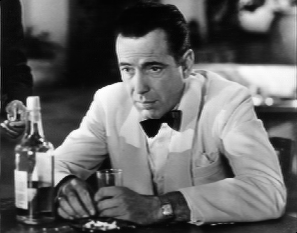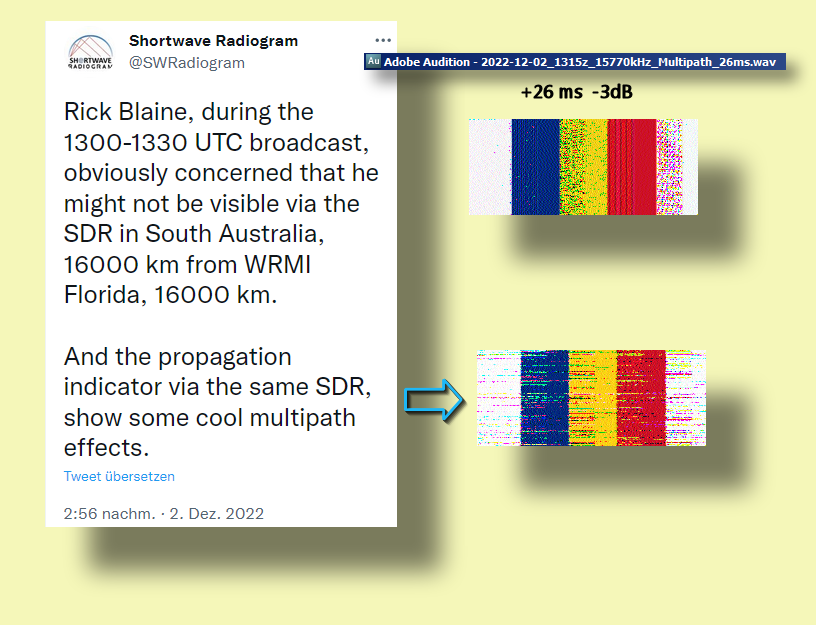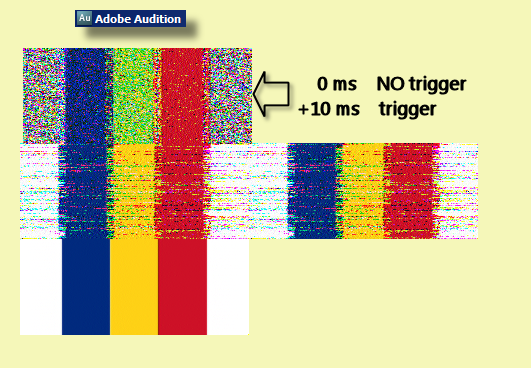http://www.rhci-online.net/radiogram/radiogram.htm

http://www.rhci-online.net/radiogram/radiogram.htm

RSID: <<2022-12-02T00:31Z MFSK-32 @ 9265000+1500>>
Welcome to program 281 of Shortwave Radiogram.
I'm Kim Andrew Elliott in Arlington, Virginia USA.
Here is the lineup for today's program, in MFSK modes as noted:
1:34 MFSK32: Program preview (now)
2:41 MFSK32: 'Casablanca' the film turns 80*
10:52 MFSK64: What happened to CubeSats launched with Artemis?
14:51 MFSK64: This week's images*
28:20 MFSK32: Closing announcements
* with image(s)
Please send reception reports to radiogram@verizon.net
And visit http://swradiogram.net
We're on Twitter now: @SWRadiogram
From Deutsche Welle:
'Casablanca': A refugee love story turns 80
Christine Lehnen
November 26, 2022
The love story starring Humphrey Bogart and Ingrid Bergman is a
timeless classic, yet its intriguing historical background is not
widely known.
When it premiered in New York City 80 years ago, no one knew that
"Casablanca" would become one of the most successful films in
cinema history.
The Warner Bros. production and entertainment company rushed the
world premiere for obvious reasons: The movie was filmed and set
during World War II.
Since the landing of Allied troops on the North African coast in
early November 1942, the city of Casablanca in Morocco had been
making headlines. While British and American soldiers walked the
streets of Morocco's largest city, Warner Bros. premiered the
film of the same name in New York City on November 26, 1942.
In "Casablanca," countless emigrants and fugitives on the run
from the Nazis have come from Europe to the city of Casablanca in
French North Africa.
They gather in Rick's Cafe, a bar run by a US citizen, and hope
to travel on to neutral Lisbon and from there by ship to the
United States.
Against this background, a love story unfolds between Rick
(Humphrey Bogart) and Ilsa Lund (Ingrid Bergman), the wife of the
famous Czech resistance fighter Victor Laszlo, who has escaped
one of Hitler's concentration camps.
Although the premiere of "Casablanca" was a great success, Warner
Bros. refrained from a nationwide cinema release in 1942. It was
not until January 23, 1943 that "Casablanca" was shown in US
theaters.
This decision may have been made due to political reasons.
During the Second World War, Casablanca was not only a meeting
place for emigrants and refugees, but also for two of the most
powerful men in the world.
US President Franklin D. Roosevelt and British Prime Minister
Winston Churchill met secretly in Casablanca from January 14-24,
1943 to forge an anti-Hitler coalition. Since Roosevelt and film
mogul Jack Warner (of Warner Bros.) were friends, it is
conceivable that Warner Bros. waited with the nationwide release
of "Casablanca” until the end of the secret, so-called
"Casablanca Conference."
Warner Bros. was the only Hollywood studio to openly position
itself against Hitler and the Nazis.
The United States had initially refused to enter the Second World
War — until the Japanese army bombed the US military base at
Pearl Harbor on Hawaii on December 7, 1941.
Immediately following the attack, the US declared war on Japan.
Japan's allies — Germany and Italy — responded with their own
declaration of war. On January 1, 1942, the US joined the
anti-Hitler coalition of Britain and the Soviet Union. The aim of
the secret meeting in Casablanca was to advance the coalition's
military operations. Eventually, the allied operations would
result in the defeat of the Wehrmacht and the end of Nazi Germany
in 1945.
A beloved classic in Germany
German audiences only got to see "Casablanca" after the end of
the war — in a radically abridged version in which the Nazis and
the Second World War don't feature at all. It was released in
1952.
In this sanitized version, Victor Laszlo becomes a Norwegian
physicist named Viktor Larsen. Instead of a resistance fighter
and fugitive from the Nazis, Larsen is portrayed as a physicist
who managed to escape from prison through harnessing mysterious
delta rays. The German branch of Warner Bros., which made the
cuts, apparently did not want to remind West Germans of their
Nazi past.
It was not until the 1970s that the German public broadcaster ARD
commissioned a German-language version of the original film,
broadcasting it for the first time in 1975. Since then,
German-speaking audiences have been able to enjoy this very
special refugee love story in its original version.
Since its US premiere 80 years ago, "Casablanca" has garnered
cult status.
Humphrey Bogart and Ingrid Bergmann delivered the performances of
their lives, and many film lovers today still remember them above
all as Rick and Ilsa. It is Bogart who utters the line that has
seared itself into the public's collective memory, one hand on
Bergman's chin: "Here's looking at you, kid!"
https://www.dw.com/en/casablanca-turns-80/a-63831468
Sending Pic:297x233;

Shortwave Radiogram now changes to MFSK64 ...
RSID: <<2022-12-02T00:41Z
MFSK-64 @
9265000+1500>>
This is Shortwave Radiogram in MFSK64
Please send your reception report to radiogram@verizon.net
From Phys.org:
What happened to those CubeSats that were launched with Artemis
I?
by Matt Williams, Universe Today
November 28, 2022
NASA made history on November 16 when the Artemis I mission took
off from Launch Complex 39B at Cape Canaveral, Florida, on its
way to the moon. This uncrewed mission is testing the
capabilities of the Space Launch System (SLS) and Orion
spacecraft in preparation for the long-awaited return to the moon
in 2025 (the Artemis III mission). Rather than astronauts, this
mission carries a group of mannequins with sensors and has a
primary payload consisting of the Callisto technology
demonstrator (a human-machine video interface system).
As a secondary payload, Artemis I also brought ten 6U CubeSats
beyond Low Earth Orbit (LEO), three of which were NASA missions
designed to perform experiments. The rest were built by partner
space agencies, commercial space entities, research institutes,
and universities to carry out a variety of unique deep-space
science experiments. While all these satellites managed to deploy
successfully, six have not made contact with controllers on the
ground or have since experienced problems, and their whereabouts
remain unknown.
The three NASA missions include the BioSentinel, which was
designed, built, and tested by engineers at NASA's Ames and will
measure the effects of deep-space radiation on DNA using yeast
organisms. The second is the Lunar Flashflight, a technology
demonstrator developed at the NASA Jet Propulsion Laboratory
(JPL) with support from the Marshall Space Flight Center (MSFC),
the Goddard Space Flight Center, and the Georgia Institute of
Technology. Its purpose is to look for surface water ice in the
permanently-shadowed regions near the lunar south pole and test
out new spacecraft technologies.
The third is the NEA Scout mission developed by the NASA Marshal
Space Flight Center in partnership with NASA JPL, with support
from NASA Goddard, the Johnson Space Center, and the Langley
Research Center. The purpose of the mission is twofold: one, to
demonstrate solar sail deployment; and two, to demonstrate solar
sail navigation by rendezvousing (and characterizing) the
near-earth asteroid (NEA) 2020 GE. The other missions include the
following:
ArgoMoon: Contributed by the European Space Agency (ESA) and
ArgoTec, an Italian aerospace company. This CubeSat aims to
observe the SLS interim cryogenic propulsion stage with
advanced optics and software imaging systems.
CuSP: Contributed by the Southwest Research Institute
(SwRI), this satellite is a "space weather" mission that
will measure solar particles and magnetic fields.
EQUULEUS: This satellite was developed by the Japan
Aerospace Exploration Agency (JAXA) and the University of
Tokyo to image Earth's plasmasphere and study Earth's
radiation environment from the Earth-Moon L2 point.
Lunar IceCube: Developed by Morehead State University, this
CubeSat will search for lunar water and other volatiles
using an infrared spectrometer.
LunaH-Map: This satellite, contributed by Arizona State
University, will use neutron spectrometers to create
higher-fidelity maps of near-surface hydrogen in
permanently-shadowed craters and other regions near the
lunar South Pole.
LunIR: Developed by Lockheed Martin, this mission will
conduct advanced infrared imaging of the lunar surface.
OMOTENASHI: Developed by JAXA, this lunar lander (the
smallest ever deployed) will study the lunar environment.
Team Miles: Developed by Florida-based aerospace company
Miles Space, this demonstrator will test plasma thrusters
and compete in NASA's Deep Space Derby Centennial Challenge
(formerly the Cube Quest Challenge).
All ten CubeSats successfully deployed from the Interim Cryogenic
Propulsion Stage (ICPS), an adapter attached to the SLS's upper
stage. On November 18th, NASA officials confirmed that ArgoMoon,
Biosentinel, Equuleus, LunaH-Map, and OMOTENASHI were all
operational, though OMOTENASHI began experiencing problems since
then. On November 24th, NASA reported that the NEA Scout mission
still hadn't made contact. This prompted the mission controllers
to deploy the CubeSat's sail ahead of schedule, hoping it will be
visible to ground-based telescopes.
In short, only four of the deployed satellites successfully
established communications with their cont0rollers back on Earth.
The teams behind the remaining six missions are currently
troubleshooting various solutions and are waiting to learn more.
But as time has taught us, such is the nature of CubeSat
missions, which are inherently high-risk and high-reward. And it
may be premature at this point to count out all the missions that
have experienced problems.
https://phys.org/news/2022-11-cubesats-artemis.html
This is Shortwave Radiogram in MFSK64
Please send your reception report to
radiogram@verizon.net
This week's images ...
Our propagation indicator is the flag of Romania (with some white
space left and right) ...
Sending Pic:229x96C;

 |
 |
Rays of the setting sun falls on the Nanda Devi mountain peak in
Auli, Uttarakhand state, India.
https://bit.ly/3VmNQBR ...
Sending Pic:221x96C;

The Incanto di Luci (Enchantment of Lights) exhibition at the
Botanical Garden of Rome, November 24.
https://bit.ly/3XQdD7d ...
Sending Pic:201x131C;

The northern lights appear over Villingaholtskirkja church on
Iceland's south coast.
https://bit.ly/3uc5mwN ...
Sending Pic:204x147C;

Sunset from Parole, Maryland, November 30.
https://bit.ly/3B04UW0
...
Sending Pic:209x104C;
A November sunset over Lake Michigan, from Indiana Dunes State
Park. https://bit.ly/3FgWBYl ...
Sending Pic:157x198C;

A robin feasting on holly berries at the Tidal Basin in
Washington DC.
https://bit.ly/3B0p2HE ...
Sending Pic:180x190C;
Our painting of the week is "Fabric Sale" (1945) by Irene Hoffar
Reid. https://bit.ly/3VCo10e ...
Sending Pic:197x177C;

Shortwave Radiogram returns to MFSK32 ...
RSID: <<2022-12-02T00:58Z
MFSK-32 @
9265000+1500>>
This is Shortwave Radiogram in MFSK32 ...
Shortwave Radiogram is transmitted
by:
WRMI, Radio Miami International, wrmi.net
and
WINB Shortwave, winb.com
Please send reception reports to
radiogram@verizon.net
And visit http://swradiogram.net
Twitter:
@SWRadiogram or twitter.com/swradiogram
I'm Kim Elliott. Please join us for the next Shortwave
Radiogram.
|
Closing music SWRG#281:
https://www.midomi.com/Track?trackID=100257561802864075&song=songbird
|
http://www.rhci-online.net/radiogram/radiogram.htm
|
QTH: |
D-06193 Petersberg (Germany/Germania) |
|
|
Ant.: |
Dipol for 40m-Band & Boomerang Antenna 11m-Band |
|
|
RX for RF: |
FRG-100B + IF-mixer & ICOM IC-R75 + IF-mixer |
|
|
Software IF: |
con STUDIO1 - Software italiano per SDR [S-AM-USB/LSB] + beta 11 Version 2.80 (August 21, 2018) - for scheduled IF-recording |
|
|
Software AF: |
Fldigi-4.0.18 + flmsg-4.0.7 images-fldigifiles on homedrive.lnk |
|
|
OS: |
German XP-SP3 with support for asian languages |
German W7 32bit + 64bit |
|
PC: |
MEDION Titanium 8008 (since 2003) [ P4 - 2,6 GHz] |
MSI-CR70-2MP345W7 (since2014) [i5 -P3560 ( 2 x 2,6GHz) ] |
http://wiki.radioreference.com/index.php/Decoding_the_SW_Radiogram_Broadcasts
https://www.qsl.net/ve7vv/Files/Digital%20Modes.pdf
RSID: <<2022-12-04T01:30Z MFSK-64 @ 5960000+1500>>
Mickey Thomas, who sang with Jefferson Starship and Starship,
was born John Michael Thomas, December 3, 1949.
Sending Pic:235x188;

starshipcontrol.com
Please report your decode to
themightykbc@gmail.com


RSID: <<2022-12-01T02:47Z
MFSK-64 @
5850000+1500>>
_____________ __ _______ ____ ______ ___
/_ __/ _/ _ | / |/ / __/_/ / /< ( _ ) _ \
/ / _/ // __ |/ /|_/ /\ \/_ . __/ / _ \_, /
/_/ /___/_/ |_/_/ /_/___/_ __/_/\___/___/
/_/_/
This Is A Music Show #189
01 December 2022
0200-0300UTC Thursday on 5850 kHz
via WRMI, Okeechobee USA
***ALSO***
TIAnExpressMS w/ Radio Northern Europe International
via Channel 292 in Germany, mainly on 6070 kHz.
Broadcast various dates/times/freqs. Check the schedule here:
https://www.channel292.de/
https://rnei.org/
----------------------------------------
PLAYLIST
The Remote Viewer - We Do What We Can
-----
Add N To X - Robot New York
Cornelius - Theme Of Curiosity Killed The Ape 2
Unknown DJ - [Tribe Called Quest - Scenario] DJ Routine
-----
Mouse On Mars - Improv Track (live at Star Pines Cafe, Kichijoji, JPN)
Stereolab - Miss Modular (live at
Liquid Room, Shibuya JPN)
Kraftwerk - Pocket Calculator/Dentaku (live at Electraglide, Makuhari JPN)
-----
Royal City - Pictures (live at Ted's Wrecking Yard, Toronto CAN)
-----
THIS DATA w/ Bert Kaempfert - Black Beauty
-----
Low - Two Step (live at The Horseshoe Tavern, Toronto CAN)
----------------------------------------
TIAMS Website:
https://thisisamusicshow.com
Go here for show archives + official shop!
-----
Please send reception reports/comments:
thisisamusicshow@gmail.com
Follow TIAMS on Twitter:
www.twitter.com/ThisIsAMusicSho/
------
Thanks for listening!
--YOUR HOST--
EOM
RSID: <<2022-12-01T02:48Z
MFSK-64 @
5850000+1500>>
Sending Pic:300x300Cp4;


|
RSID: <<2022-12-04T PSK-500R @
+1500>>
|